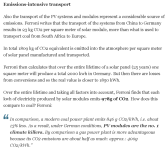I think as time goes on all the metals used to make lithium batteries will go up considerably
For example, take the company Queensland Nickel which has happens to have "open and close" operations news on a frequent basis.
https://en.wikipedia.org/wiki/Queensland_Nickel
https://goo.gl/maps/4wY6JZ8dKJ9ttxzS9
What makes this company viable or not is whether it can get cheap energy to continue to run and be profitable vs other nickel miners/refiners around the world.
If the quality of the raw nickel ore goes down then it needs to find access to cheaper energy to compete with its competitors globally to continue.
This is one of the reasons why Queensland shows up remarkably dark on EM, it's to have cheap energy to produce the raw metals for batteries/EVs so people can have affordable/cheap EVs.
https://www.electricitymap.org/?wind=false&solar=false&page=country&countryCode=AUS-QLD&remote=true
China with its 10km2 radioactive sludge lake was built with the same mind-frame, to have cheap elements refined.
But just like how China has banned importing rubbish for recycling as it increases its environmental standards for a better quality of living so will the cheaply made/refined metals.
As long as people demand a cleaner environment in Queensland etc the only direction the price of metals will go is upwards as there will be demands for more energy to refine metals in a cleaner method. The only way to make a process cleaner is to use more energy to clean up after the process is complete. Even Queensland Nickel has a very dirty mine site that still needs to be cleaned up if its never to re-open.
The cost is always more energy.
Mining and refining metals is a dirty and secretive industry, no one wants to tell people they make radioactive sludge lakes for a living
https://www.dailymail.co.uk/home/moslive/article-1350811/In-China-true-cost-Britains-clean-green-wind-power-experiment-Pollution-disastrous-scale.html
or burn 10 times the amount of coal they were 10 years ago because the quality of ore they refine has diminished.
The reason this PDF was produced and made public, is due to the fact that, for a nickel mine, its creators were PROUD of the idea they could mine and refine nickel and produce merely 57.9 times its own weight in co2, quote "
57.9 tonnes of co2 emitted per 1 tonne of nickel."
https://epa.tas.gov.au/documents/proto%20resources%20-%20barnes%20hill%20nickel%20laterite%20project%20dpemp.pdf
^This document goes in detail for nickel mining/refining in Tasmania which is almost entirely hydro electricity based to produce merely 57 tonnes of co2 for every tonne of nickel produced.
https://www.electricitymap.org/?wind=false&solar=false&page=country&countryCode=AUS-TAS&remote=true
Like this chart shows, producing nickel at over 120 tonnes of co2 for every single tonne of nickel produced is not uncommon.
https://endless-sphere.com/forums/download/file.php?id=251471&mode=view
MAY 3, 2019 Exclusive: Tesla expects global shortage of electric vehicle battery minerals -sources
https://www.reuters.com/article/usa-lithium-electric-tesla-exclusive-int-idUSKCN1S81QI
Tesla Inc expects global shortages of nickel, copper and other electric-vehicle battery minerals down the road due to underinvestment in the mining sector, the company’s global supply manager for battery metals told an industry conference on Thursday, according to two sources.
The company, a major minerals consumer, has rarely talked publicly about its views on the metals industry. Copper, nickel, lithium and related minerals are key components used to make electric-vehicle batteries
will consume about 1.5 million tonnes of copper by 2030, up from 38,000 tonnes today, according to data from consultancy BSRIA
All the facts point to the reality that EV's are really about CO2 displacement, the process of pre-emitting or putting the co2 somewhere else for the vehicle to work. In fact, it works out so well that it almost seems to be a law of physics in some way, perhaps because everything is built on the back of fossil fuel, even solar/wind contraptions.
Aside from EV's seemingly having a neutral or worse "co2 displacement law", so does the lifetime co2 footprint of solar panels according to this study.

As time goes on, and IMO on a pretty short timeline basis, the energy required and the co2 emissions will only continue to go up as the most easily mined raw metal ore deposits get used up.



